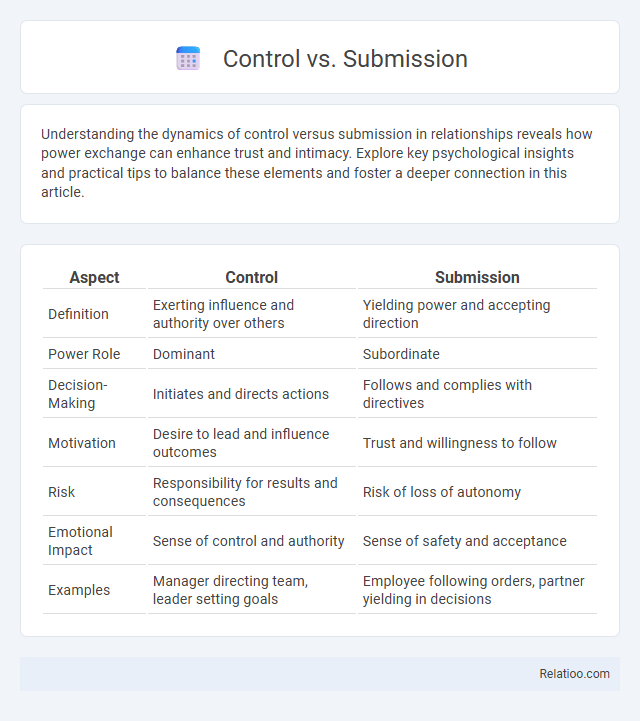Understanding the dynamics of control versus submission in relationships reveals how power exchange can enhance trust and intimacy. Explore key psychological insights and practical tips to balance these elements and foster a deeper connection in this article.
Table of Comparison
| Aspect | Control | Submission |
|---|---|---|
| Definition | Exerting influence and authority over others | Yielding power and accepting direction |
| Power Role | Dominant | Subordinate |
| Decision-Making | Initiates and directs actions | Follows and complies with directives |
| Motivation | Desire to lead and influence outcomes | Trust and willingness to follow |
| Risk | Responsibility for results and consequences | Risk of loss of autonomy |
| Emotional Impact | Sense of control and authority | Sense of safety and acceptance |
| Examples | Manager directing team, leader setting goals | Employee following orders, partner yielding in decisions |
Understanding Control and Submission
Understanding control involves recognizing the ability to direct or influence actions and decisions, while submission entails willingly yielding power or authority to another. Your awareness of these dynamics enhances interpersonal relationships by balancing assertiveness with receptivity. Mastery of control and submission leads to effective cooperation without compromising autonomy or respect.
Defining Control: Key Characteristics
Control is characterized by the power to direct or influence behavior and decisions, often involving authority and the ability to enforce rules or standards. It entails maintaining dominance over resources or individuals to achieve desired outcomes through regulation, supervision, or command. Unlike submission or subordination, control emphasizes active management and intentional exercise of influence rather than passive compliance.
What is Submission? Core Concepts
Submission involves yielding power or authority to another individual, often within hierarchical or relational dynamics. Core concepts include voluntary consent, trust, and a clear understanding of boundaries and roles, emphasizing mutual respect despite the asymmetry of power. Unlike subordination, which is often imposed by external structures, submission typically implies an active choice aligned with personal or relational goals.
The Psychology Behind Control
Control in psychological terms involves an individual's desire to influence or direct outcomes, often tied to a need for security, predictability, and self-efficacy. Submission typically reflects a conscious or unconscious choice to yield power, often linked to trust, vulnerability, or social harmony. Subordination implies a hierarchical dynamic where the subordinate accepts a lower status, influenced by social structures, authority, and the psychological mechanisms of compliance and obedience.
Why Do People Submit?
People submit due to a variety of psychological and social factors, including trust, fear, desire for safety, or the need for structure and order in complex situations. Submission often arises from the belief that relinquishing control will lead to better outcomes or reduced conflict in relationships or hierarchies. Understanding your own motivations for submission can help you navigate power dynamics more effectively and maintain healthy boundaries.
Healthy vs Unhealthy Control
Healthy control fosters mutual respect and clear boundaries, promoting autonomy and collaboration in relationships or organizations. Unhealthy control manifests as manipulation, coercion, and dominance, leading to resentment, decreased trust, and emotional harm. Understanding your role in balancing control with submission and subordination helps maintain psychological well-being and functional dynamics.
Voluntary vs Involuntary Submission
Control involves directing actions or behavior, while submission refers to yielding or surrendering authority, which can be either voluntary or involuntary. Voluntary submission occurs when you choose to relinquish control based on trust or respect, enhancing cooperation and mutual understanding. Involuntary submission, however, results from external pressure or coercion, often leading to resentment and diminished autonomy.
Control and Submission Dynamics in Relationships
Control in relationships involves one partner exerting influence or authority over decisions and behaviors, often seeking to maintain power balance. Submission entails willingly yielding to the other's control, fostering trust and emotional safety when consensual and mutual. Understanding these dynamics helps navigate boundaries and promotes healthy interaction without undermining autonomy or respect.
Breaking the Cycle: Empowering Change
Breaking the cycle of control, submission, and subordination requires recognizing ingrained power dynamics and fostering self-awareness as a foundation for empowerment. Emphasizing personal agency enables individuals to challenge oppressive structures and cultivate mutual respect and cooperation in relationships. Transformative change arises from reclaiming autonomy, setting healthy boundaries, and promoting equitable interactions that disrupt patterns of dominance and compliance.
Cultivating Balance: Mutual Respect and Autonomy
Control emphasizes directing actions, while submission involves yielding to another's influence, and subordination denotes a hierarchical positioning. Cultivating balance requires mutual respect, where each person honors the other's autonomy without dominating or surrendering entirely. Your ability to maintain this equilibrium fosters healthy relationships grounded in trust and individual empowerment.

Infographic: Control vs Submission
 relatioo.com
relatioo.com